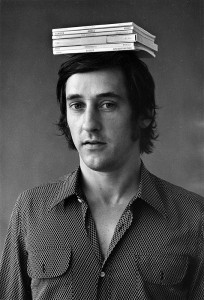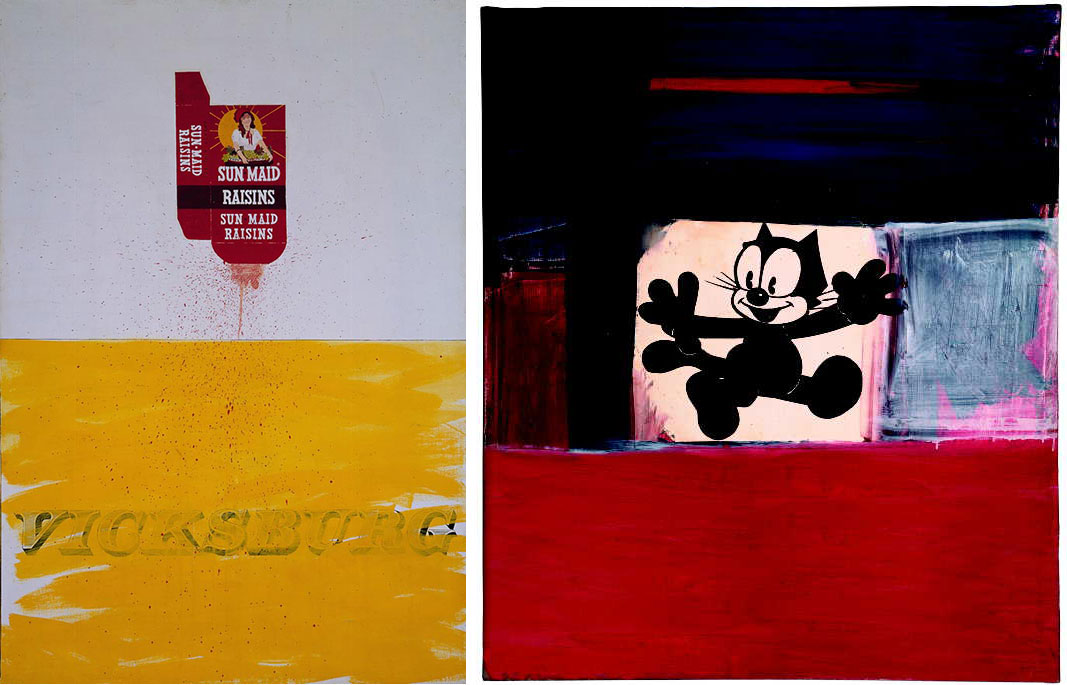TRACES: Ed Ruscha
 Today is the occasion to bear in mind Ed Ruscha (16/12/1937- ), who is widely regarded as one of the world’s most important artists with a career spanning six decades from the early 1960s until the present day, his works provided a new way of looking at and thinking about what constitutes the American scene, as well as connecting the verbal with the visual. Through documents or interviews, starting with: moments and memories, we reveal out from the past-unknown sides of big personalities, who left their indelible traces in time and history…
Today is the occasion to bear in mind Ed Ruscha (16/12/1937- ), who is widely regarded as one of the world’s most important artists with a career spanning six decades from the early 1960s until the present day, his works provided a new way of looking at and thinking about what constitutes the American scene, as well as connecting the verbal with the visual. Through documents or interviews, starting with: moments and memories, we reveal out from the past-unknown sides of big personalities, who left their indelible traces in time and history…
By Efi Michalarou
 Ed Ruscha (Edward Joseph Ruscha) was born in Omaha, Nebraska to a Roman Catholic family When Ruscha moved to Los Angeles in 1956 to attend Chouinard, (now known as the California Institute of Arts), he was instantly attracted to the Los Angeles lifestyle. During his time in art school, he had been painting in the manner of Franz Kline and Willem de Kooning, and came across a reproduction of Jasper Johns’ “Target with Four Faces” (1955). Struck by Johns’s use of readymade images as supports for abstraction, Ruscha began to consider how he could employ graphics in order to expose painting’s dual identity as both object and illusion. After Ruscha graduated, he went on a trip to Europe in the summer of 1961 with his mother and brother. They traveled for four months, buying a small car in Paris and using it to visit countries all over Europe. Ruscha visited museums, but found he wasn’t gripped by the art of previous centuries. Instead, when he returned to Paris at the end of the trip, he spent time walking through the streets and painting local signage, such as those above the Metro stations. After returning to Los Angeles, he worked for the Carson-Roberts Advertising Agency designing layouts. He also started to pursue his career as an artist seriously at this point. His teachers had trained him to “face the canvas and let it happen, follow your own gestures, let the painting create itself”. But he eschewed this direction as well as the prevailing Abstract Expressionism of the time to instead find his own style, which drew on popular culture and his love of the city. In 1962, Ruscha was invited to show his work as part of the “New Painting of Common Objects” exhibition at the Pasadena Art Museum, curated by Walter Hopps. The show is generally credited as the first museum exhibition in America showing what would later be dubbed Pop art. Ruscha, the youngest artist in the group, showed his work alongside pieces by Roy Lichtenstein, Jim Dine, Joe Goode, Wayne Thiebaud and Andy Warhol. The following year, Hopps invited Ruscha to put on his first solo exhibition at the Ferus Gallery. The same year he produced his first artist’s book, “Twentysix Gasoline Stations”, with photographs he took as he travelled along Route 66, between Los Angeles and his parents’ home in Oklahoma City, taking in Arizona, New Mexico and Texas. The pictures, which have no people in them, do not document a particular journey and there is no sense of narrative or story. It was the first of seventeen books that Ruscha made throughout the 1960s and 70s. These books are characterised by their use of serial photography, a wry sense of humour and use of small amounts of text. The titles of the books such as “Every Building on Sunset Strip” (1966) and “Thirtyfour Parking Lots” (1967) function as banal descriptions of the subject matter. From the late 1960s to the mid-1970s, Ruscha painted in alternative mediums such gunpowder, food, condiments and blood. He used these materials to reflect contemporary American life: what people ate and used every day. An example from this period is “Corrosive Liquids” (1973), using gunpowder on paper. During the eighties, Ruscha executed a series of drawings incorporating vegetable pigment. These works depicted a mysteriously cast light and phrases such as “99% DEVIL, 1% ANGEL”. The artist’s use of light beams may be attributed to his Catholic upbringing, and illumination as a symbol of the divine comes into play in many of his paintings. Still, Ruscha claims no particular moral or spiritual position. In 1985, Ruscha executed his first public commission, a mural for the Miami Dade Public Library that displays the phrase “Words Without Thoughts Never to Heaven Go”. Since 1990, Ruscha has produced several larger works depicting empty rooms into which light projects. He has also recently experimented with curved canvases, while continuing to approach his word paintings in new and innovative ways.
Ed Ruscha (Edward Joseph Ruscha) was born in Omaha, Nebraska to a Roman Catholic family When Ruscha moved to Los Angeles in 1956 to attend Chouinard, (now known as the California Institute of Arts), he was instantly attracted to the Los Angeles lifestyle. During his time in art school, he had been painting in the manner of Franz Kline and Willem de Kooning, and came across a reproduction of Jasper Johns’ “Target with Four Faces” (1955). Struck by Johns’s use of readymade images as supports for abstraction, Ruscha began to consider how he could employ graphics in order to expose painting’s dual identity as both object and illusion. After Ruscha graduated, he went on a trip to Europe in the summer of 1961 with his mother and brother. They traveled for four months, buying a small car in Paris and using it to visit countries all over Europe. Ruscha visited museums, but found he wasn’t gripped by the art of previous centuries. Instead, when he returned to Paris at the end of the trip, he spent time walking through the streets and painting local signage, such as those above the Metro stations. After returning to Los Angeles, he worked for the Carson-Roberts Advertising Agency designing layouts. He also started to pursue his career as an artist seriously at this point. His teachers had trained him to “face the canvas and let it happen, follow your own gestures, let the painting create itself”. But he eschewed this direction as well as the prevailing Abstract Expressionism of the time to instead find his own style, which drew on popular culture and his love of the city. In 1962, Ruscha was invited to show his work as part of the “New Painting of Common Objects” exhibition at the Pasadena Art Museum, curated by Walter Hopps. The show is generally credited as the first museum exhibition in America showing what would later be dubbed Pop art. Ruscha, the youngest artist in the group, showed his work alongside pieces by Roy Lichtenstein, Jim Dine, Joe Goode, Wayne Thiebaud and Andy Warhol. The following year, Hopps invited Ruscha to put on his first solo exhibition at the Ferus Gallery. The same year he produced his first artist’s book, “Twentysix Gasoline Stations”, with photographs he took as he travelled along Route 66, between Los Angeles and his parents’ home in Oklahoma City, taking in Arizona, New Mexico and Texas. The pictures, which have no people in them, do not document a particular journey and there is no sense of narrative or story. It was the first of seventeen books that Ruscha made throughout the 1960s and 70s. These books are characterised by their use of serial photography, a wry sense of humour and use of small amounts of text. The titles of the books such as “Every Building on Sunset Strip” (1966) and “Thirtyfour Parking Lots” (1967) function as banal descriptions of the subject matter. From the late 1960s to the mid-1970s, Ruscha painted in alternative mediums such gunpowder, food, condiments and blood. He used these materials to reflect contemporary American life: what people ate and used every day. An example from this period is “Corrosive Liquids” (1973), using gunpowder on paper. During the eighties, Ruscha executed a series of drawings incorporating vegetable pigment. These works depicted a mysteriously cast light and phrases such as “99% DEVIL, 1% ANGEL”. The artist’s use of light beams may be attributed to his Catholic upbringing, and illumination as a symbol of the divine comes into play in many of his paintings. Still, Ruscha claims no particular moral or spiritual position. In 1985, Ruscha executed his first public commission, a mural for the Miami Dade Public Library that displays the phrase “Words Without Thoughts Never to Heaven Go”. Since 1990, Ruscha has produced several larger works depicting empty rooms into which light projects. He has also recently experimented with curved canvases, while continuing to approach his word paintings in new and innovative ways.













